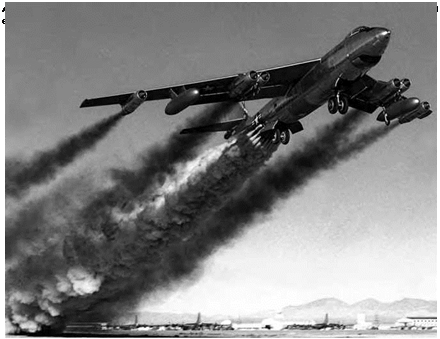Advancing Propulsive Technology
James Banke
![]() Ensuring proper aircraft propulsion has been a powerful stimulus. In the interwar years, the NACA researched propellers, fuels, engine cooling, supercharging, and nacelle and cowling design. In the postwar years, the Agency refined gas turbine propulsion technology. NASA now leads research in advancing environmentally friendly and fuel-conserving propulsion, thanks to the Agency’s strengths in aerodynamic and thermodynamic analysis, composite structures, and other areas.
Ensuring proper aircraft propulsion has been a powerful stimulus. In the interwar years, the NACA researched propellers, fuels, engine cooling, supercharging, and nacelle and cowling design. In the postwar years, the Agency refined gas turbine propulsion technology. NASA now leads research in advancing environmentally friendly and fuel-conserving propulsion, thanks to the Agency’s strengths in aerodynamic and thermodynamic analysis, composite structures, and other areas.
|
E |
ACH DAY, OUR SKIES FILL with general aviation aircraft, business jets, and commercial airliners. Every 24 hours, some 2 million passengers worldwide are moved from one airport to the next, almost all of them propelled by relatively quiet, fuel-efficient, and safe jet engines.[1291]
And no matter if the driving force moving these vehicles through the air comes from piston-driven propellers, turboprops, turbojets, turbofans— even rocket engines or scramjets—the National Aeronautics and Space Administration (NASA) during the past 50 years has played a significant role in advancing that propulsion technology the public counts on every day.
Many of the advances seen in today’s aircraft power-plants can trace their origins to NASA programs that began during the 1960s, when the Agency responded to public demand that the Government apply major resources to tackling the problems of noise pollution near major airports. Highlights of some of the more noteworthy research programs to reduce noise and other pollution, prolong engine life, and increase fuel efficiency will be described in this case study.
But efforts to improve engine efficiency and curb unwanted noise actually predate NASA’s origins in 1958, when its predecessor, the National Advisory Committee for Aeronautics (NACA), served as the Nation’s preeminent laboratory for aviation research. It was during the 1920s that
 |
|
the NACA invented a cowling to surround the front of an airplane and its radial engine, smoothing the aerodynamic flow around the aircraft while also helping to keep the engine cool. In 1929, the NACA won its first Collier Trophy for the breakthrough in engine and aerodynamic technology.[1292]
During World War II, the NACA produced new ways to fix problems discovered in higher-powered piston engines being mass-produced for wartime bombers. NACA research into centrifugal superchargers was particularly useful, especially on the R-1820 Cyclone engines intended for use on the Boeing B-17 Flying Fortress, and later with the Wright R-3350 Duplex Cyclone engines that powered the B-29.
Basic research on aircraft engine noise was conducted by NACA engineers, who reported their findings in a paper presented in 1956 to the 51st Meeting of the Acoustical Society of America in Cambridge, MA. It would seem that measurements backed up the prediction that the noise level of the spinning propeller depended on several variables,
including the propeller diameter, how fast it is turning, and how far away the recording device is from the engine.[1293]
![]() As the jet engine made its way from Europe to the United States and designs for the basic turboprop, turbojet, and turbofan were refined, the NACA during the early 1950s began one of the earliest noise-reduction programs, installing multitube nozzles of increasing complexity at the back of the engines to, in effect, act as mufflers. These engines were tested in a wind tunnel at Langley Research Center in Hampton, VA. But the effort was not effective enough to prevent a growing public sentiment that commercial jet airliners should be seen and not heard.
As the jet engine made its way from Europe to the United States and designs for the basic turboprop, turbojet, and turbofan were refined, the NACA during the early 1950s began one of the earliest noise-reduction programs, installing multitube nozzles of increasing complexity at the back of the engines to, in effect, act as mufflers. These engines were tested in a wind tunnel at Langley Research Center in Hampton, VA. But the effort was not effective enough to prevent a growing public sentiment that commercial jet airliners should be seen and not heard.
In fact, a 1952 Presidential commission chaired by the legendary pilot James H. Doolittle predicted that aircraft noise would soon turn into a problem for airport managers and planners. The NACA’s response was to form a Special Subcommittee on Aircraft Noise and pursue a three – part program to understand better what makes a jet noisy, how to quiet it, and what, if any, impact the noise might have on the aircraft’s structure.[1294]
As the NACA on September 30, 1958, turned overnight into the National Aeronautics and Space Administration on October 1, the new space agency soon found itself with more work to do than just beating the Soviet Union to the Moon.










